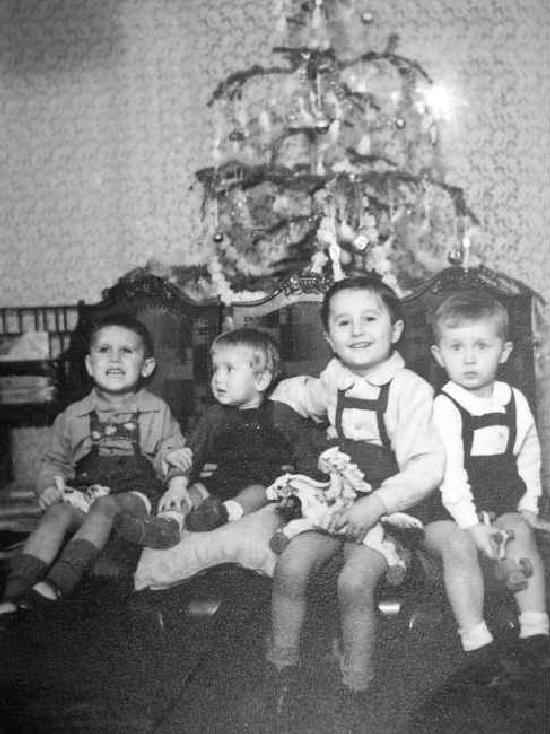
Figure 1.-- Here we see German children in front of the family Christmas tree. The photograph is undated, but we would guess was taken in the 1930s. |


|
German readers tell us about many popular holiday traditions in their country. English and American readers will recognize many of them. Christmas as well as other traditions such as weddings in America and Britain were largely set in the Victorian era. And many of them were influenced by the German traditions Prince Albert brought from Germany to the delight of the royal family. These were gradually adopted by families all over Britain and then America. The custom of trimming and lighting a Christmas tree had its origin in pre-Christian Germany, the tree symbolizing the Garden of Eden. It was called the "Paradise Baum," or tree of Paradise. Gradually, the custom of decorating the tree with cookies, fruit and eventually candles evolved. Another German custom to await Christmas by lighting a candle every weekend. Those candles are bound within a round piece of wire, to that are leaves and green needle trees brances are attached. These Adventskršnze called pieces were first produced in about 1910. One charming German Christmas tradition is the Adventskalnder. This custom from around 1900 is to buy calendars with stories and pictures, that are hidden behind small doors. Each day you can open one of these doors to read a story and when the last 24th day is over, Christmas Eve is there. The highlight of the Christmas food is the cookies. There are dozens of different cookies, shaped like figures of Christmas or stamped with familiar designs. Edible trees and tiny baked brown gnomes fill the warm kitchens for a week before the festivities.
One charming German Christmas tradition is the Adventskalnder.
THis custom from around 1900 is to buy calendars with stories and pictures, that are hidden behind small doors. Each day you can open one of these doors to read a story and when the last 24th day is over, Christmas Eve is there. It is a special Christmaa card for children. The card has 24 little windows which the child begins opening on December 1. Each has aovely little drrawing behind it. Of course the last window is opened Christmast even. This gives a child something to open each day as suspense grows while Chrismas gets closer and closer. A german reader has sent us a sample card with a classic design, but there are many different styles available. This is a very clever holiday tradition. I have never seen these cards offered here in America.
Another German tradition is the Adventskranz (advent wreath). There are 4 candles on it. Every Advent sunday a candle is lighted. So on the 4th of Advent all candles are lit. An Adventskranz can be seen in the Adventskalnder archived on HBC. In the drawing you can only see two of the candles. A HBC reader has sent us an image.
Another German custom to await Christmas by lighting a candle every weekend. Those candles are bound within a round piece of wire, to that are leaves and green needle trees brances are attached. These Adventskršnze called pieces were first produced in about 1910. Its predestor was a Kronleuchter (large lamps with many lights on them) of a similar kind under which the protestant Johann Heinrich Wichern (founder of the social welfare home "Rauhes Haus" in Hamburg) held his ceremon in 1838.
The highlight of the Christmas food is the cookies. There are dozens of different cookies, shaped like figures of Christmas or stamped with familiar designs. Edible trees and tiny baked brown gnomes fill the warm kitchens for a week before the festivities.
Lebkuchen are sweets baked for Christmas. I think there is no translation that could really describe it. It is gingerbread weith destintive decorations. Lebkuchen can be seen in Adventskalnder archived on HBC. They are the blasck items with dots like faces. The "dots" are almonds to decorate the Lebkuchen.
German Christmas markets evoke a wonderful seasinal atmosphere. A German reader tells us, "Special Christmas markets in Germany are rather pretty. They are made like a little village of small huts and lots of Christmas trees and very many decorations and lights. You can buy things related to Christmas and presents. You can eat and drink Christmas market typical stuff (very delicious), sometimes there is music, some attractions for children, ... You can find them everywhere in Germany. Some people travel through
different towns to see as much Christmas markets as possible. Tourists planning to visit Germany during December should visit one of these Christmas markets." We see these markets in other European countries as well, including Italy. Historic Christmas markets can be found in cities, towns, and villages throughout Germany. And they appear to be becoming increasingly popular. The Christmas fairs and markets are unique. Many of the markets held in other countries were inspired by the German tradition. The unique aspect of these markets is that they offer a variety of gifts that are arisan craftwork of varying quality and not mass produced. The merchants offer all kinds of traditional items. One of the most popular items is crib figurines--but never plastic. We also see a variety of toys, wood carvings, marionettes, candles, lambskin shoes, and much more. And there are a range ofv traditional treats. Shoppers can fortify themselves with a glass of mulled wine you may be offered. Other treats incluse baked apples, chessnuts, grilled sausages, and much more. These aromas of course add to the ambiance. And there all kinds of sweet treats for the children, including gingerbread (Lebkuchen), marzipan, cotton candy, and other sweet attractions.
German children have Father Christmas rather than Santa Clause. Like Santa he brings presents. We note a lot of German family photographs with Father Christmas. An example is an unidentified boy about 1960.
The custom of trimming and lighting a Christmas tree had its origin in pre-Christian Germany, the tree symbolizing the Garden of Eden. It was called the "Paradise Baum," or tree of Paradise. Gradually, the custom of decorating the tree with cookies, fruit and eventually candles evolved. I am not sure how the Paradise Tree evolved into a Christmas tree. One Germany reader indicates that the Christmas tree is a relatively recent development appearing only in the 16th century. It was first mentioned in 1539 at Strassburg in Alsace. Possibly it was erected in a public place, as it became common to place them at home only in the second half of the 19th century. Other countries soon adapted the custom. Charles Dickens called it "The Pretty German Toy." Although the crib is often found in German homes, the tree is the center of attention. Every Christian German home must have one. Usually it is the mother who decorates the tree and no one is allowed in until it is finished.
Navigate the Boys' Historical Clothing Web holiday pages:
[Return to the Main German Christmas page]
[New Years]
[Valetines]
[St. Patrick's Day]
[Easter]
[Fourth of July]
[Haloween]
[Thanksgiving]
[Christmas]
Navigate the Boys' Historical Clothing Web Site:
[Introduction]
[Activities]
[Biographies]
[Chronology]
[Clothing styles]
[Countries]
[Topics]
[Bibliographies]
[Contributions]
[FAQs]
[Glossaries]
[Images]
[Links]
[Registration]
[Tools]
[Boys' Clothing Home]
